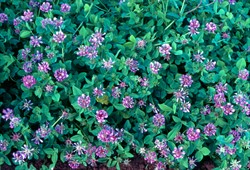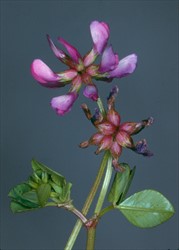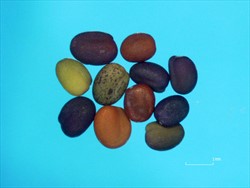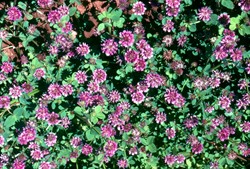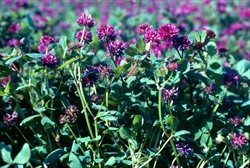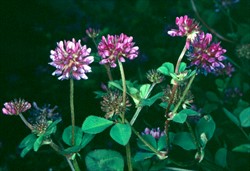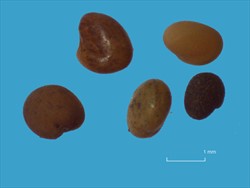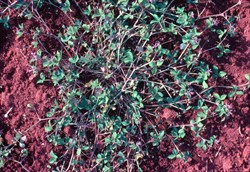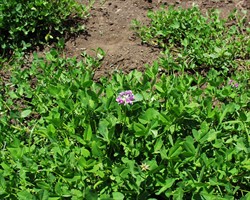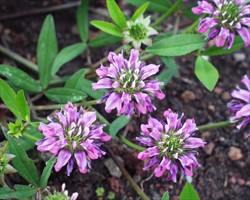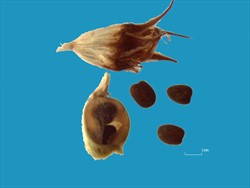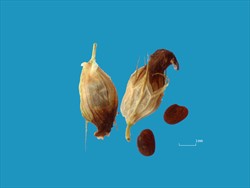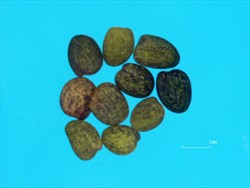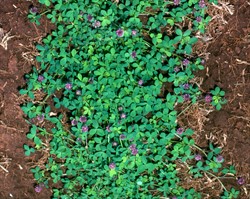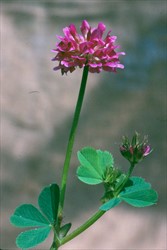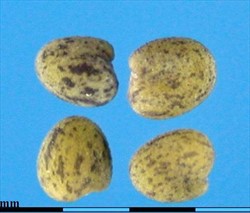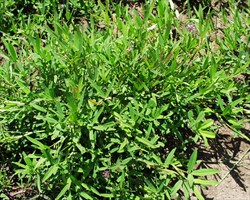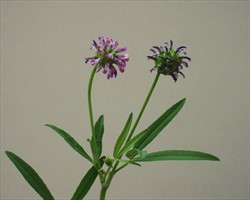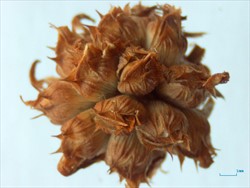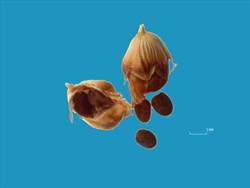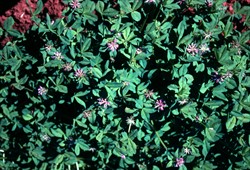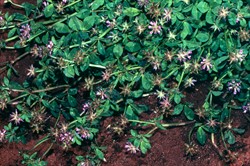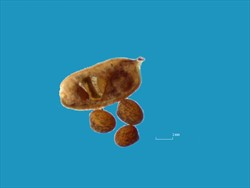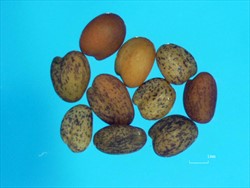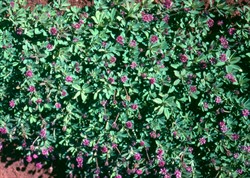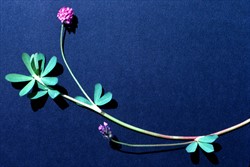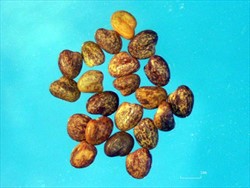Trifolium spp. African annual
Tropical Forages
Trifolium decorum Chiov.
Trifolium mattirolianum Chiov.
Trifolium quartinianum A. Rich.
Trifolium rueppellianum Fresen.
Trifolium steudneri Schweinf.
Trifolium tembense Fresen.
Trifolium usambarense Taub.
T. rueppellianum: Trifolium subrotundum Steud. & Hochst. ex A. Rich.
T. tembense: Trifolium umbellulatum A. Rich.
Family: Fabaceae (alt. Leguminosae) subfamily: Faboideae tribe: Trifolieae.
T. decorum: Herbaceous annual to 50 cm tall, stems ascending, glabrous. Leaflets ovate to suborbicular, 30‒45 × 18‒28 mm, narrowed towards base and with finely toothed margins, especially in the upper part. Petioles up to 120 mm long on lower leaves, upper leaves short-stalked. Stipules ovate-acuminate up to 10 mm. Inflorescences almost round 15‒25 mm diameter, 6‒15-flowered, long pedunculate of 20‒60 mm borne in the axils of leaves. Calyx about 5 mm long, 15‒25 nerved; lobes triangular, 2‒3 mm long, sparsely pilose at the margins. Corolla purple, 10‒14 mm long, twice as long as calyx or more, standard slightly longer than the wings and keel. Pods 6 mm long and 3-5 seeded. Seeds oval, brown and usually 1.5 × 2 mm.
T. mattirolianum: Herbaceous annual to 30 cm tall, erect or decumbent, branching all along deeply grooved stems, glabrous. Leaflets obovate, up to 16 × 14 mm, usually truncate or emarginate at the apex; margins finely spiny-toothed and veins prominent. Petiole up to 50 mm long, in upper leaves much shorter. Stipules with acuminate tips usually united to leaf stalks for about half of length, margins smooth or ragged. Inflorescences 10‒20 mm diameter, globose, many-flowered. Pedicels about 0.5 mm long; peduncle long, glabrous. Calyx glabrous, 11-nerved, becoming somewhat inflated and constricted at the throat; lobes abruptly narrowed near the base, subulate, 2‒6 mm long. Corolla purple or rarely white, 7‒10 mm long; standard longer than the wings and keel. Pods about 3 mm long, enclosed in calyx tube, 1‒2-seeded and not dehiscent. Seeds oval, brown and usually up to 1.5 × 2 mm.
T. quartinianum: Herbaceous annual to 60 cm tall, sub-glabrous, with stout, erect or spreading, grooved and branched stems. Leaflets narrowly oblong, approximately 52 × 16 mm with fine teeth. Petioles up to 40 mm long on lower leaves. Stipules 10‒20 mm long with narrowly triangular tips. Inflorescences about 20 mm in diameter and globose, long-pedunculate, bracts several-nerved forming an involucre, outer bracts ovate, lobed or toothed, up to 7 mm long. Calyx about 40-nerved, lobes 4‒7 mm long, ovate and overlapping at the base, drawn out into subulate points. Corolla purplish red, occasionally white, 11‒12 mm long. Pods about 4 mm long and 4‒5 seeded. Seeds oval, brown and usually 1.5 × 1 mm.
T. rueppellianum: Herbaceous annual to 50 cm tall, stems glabrous or pilose, erect or decumbent. Leaflets oblong or obovate, approximately 24 × 18 mm, rounded to emarginate at the apex, glabrous or sparsely pilose, toothed margin. Petiole up to 7 cm long, in upper leaves short or wholly united with stipules. Stipules up to 15 mm long, united with petiole for two thirds of their length, with acuminate tips, entire. Inflorescences globose, usually 15‒30-flowered, about 17 mm across. Pedicels up to 2 mm long. Peduncle long, pilose near the top, bracts minute. Calyx glabrous or pilose, usually 11-nerved; lobes abruptly narrowed near the base, subulate for most of their length, 2‒5 mm long and sometimes exceeding the corolla. Corolla purple or rarely white, 5‒8 mm long. Pods 3‒4 mm long and usually 2‒3-seeded. Seeds oval, brown and usually 1.5 × 1 mm. This is a very variable species and several distinct ecotypes have been identified.
T. steudneri: Herbaceous glabrous annual to 60 cm tall with many erect to spreading, grooved stems. Leaflets narrowly elliptic, approximately 40 × 8 mm, margins finely toothed. Petioles up to 50 mm long with upper leaves on shorter petioles. Stipules up to 25 mm long with narrowly triangular tips. Inflorescences globose, about 10‒20-flowered, up to 13‒20 mm across, short-pedunculate. Bracts several-nerved forming an involucre, outer bracts abruptly and sharply pointed, up to 7 mm long, inner bracts oblong, 3 mm long. Calyx about 40-nerved, glabrous or occasionally pilose; lobes triangular, 2‒3 mm long. Corolla purplish, 7‒8 mm long, sometimes with filiform tips. Pods 4 mm long and usually 2‒4-seeded. Seeds oval, brown and usually 1.5 × 2 mm.
T. tembense: Herbaceous annual, stems numerous, erect or spreading, sometimes rooting at the nodes, glabrous or nearly so. Leaflets elliptic or obovate, approximately 20 × 10 mm, narrowed at the base and with toothed margins. Petioles up to 5 cm long, in upper leaves very short or wholly united with stipules. Stipules about 15 mm long and with the free part abruptly contracted to a fine point. Inflorescences usually globose, 3‒16-flowered, up to 23 mm across, long pedunculate. Calyx 5‒7 mm long, sparsely pilose at margins, 11-nerved; lobes about 5 mm long, twice as long as tube and gradually narrowing from the 1.5 mm wide base, with broad scarious margins. Corolla purple or rarely white; standard longer than wings and keel and about 9 mm long, abruptly narrowed above the middle into an oblong, truncate, down-curved tip. Pods 5‒8 mm long, glabrous, 4‒6 seeded. When ripe, pods dehisce along the top prominent margin for seed dispersal. Seeds oval, brown and usually 1.5 × 1 mm.
T. usambarense: Annual or short-lived herbaceous perennial with stems erect or ascending, to 1 m long, branching throughout, glabrous below, sparsely pilose above, often rooting at the lower nodes. Leaflets cuneate-oblanceolate, 6‒22 × 3‒7 mm, usually rounded at the apex and narrow at the base, glabrous or nearly so. Petioles united with stipules for all their length; stipules about 10 mm long with the free part triangular-acuminate. Inflorescences globose or elongate ovoid borne both terminally and in the axils of leaves, many-flowered, 9‒18 × 7‒13 mm. Peduncle to 6 cm long, pilose above; bracts minute. Calyx usually pilose, 10‒11-nerved; lobes subulate, about 3 mm long. Corolla purple (rarely white) with broad elliptical standard, 4‒7 mm long. Pods 2‒3 mm long and usually 2-seeded. Seeds oval, brown and usually 1.5 × 1 mm.
T. quartinianum
English: Quartin’s clover
T. rueppellianum
English: Rueppell's clover
T. steudneri
English: Steudner's clover
T. tembense
English: Tembien clover
T. usambarense
English: Usmabara clover; German: Usambara-Klee; Chichewa, Malawi: therere
T. decorum, T. mattirolianum
Native: Africa: Ethiopia
T. quartinianum
Native: Africa: Eritrea; Ethiopia; Uganda
T. rueppellianum
Native: Africa: Cameroon; Democratic Republic of the Congo; Equatorial Guinea (Bioko); Ethiopia; Kenya; Rwanda; Sudan; Tanzania.
Cultivated: Widespread in tropical Africa.
T. steudneri
Native: Africa: Eritrea; Ethiopia; Kenya; Uganda
T. tembense
Native: Africa: Democratic Republic of the Congo; Eritrea; Ethiopia; Kenya; Rwanda; Tanzania; Uganda
T. usambarense
Native: Africa: Burundi; Cameroon; Democratic Republic of the Congo; Ethiopia; Equatorial Guinea (Bioko); Kenya; Malawi; Nigeria; Rwanda; Tanzania; Uganda; Zambia
Forage
The East African annual Trifolium spp. are considered to make a valuable contribution in native pasture grazing systems, with potential for use as annual legumes for pasture improvement in high altitude areas. They can be used for intercropping with wheat or barley in tropical highlands to improve quality of residues for livestock feed, and can also be used for hay and silage production.
Environment
Used for intercropping with wheat or barley in tropical highlands to improve soil nitrogen.
Other
These are all excellent species for bee keeping and honey production.
Soil requirements
These Trifolium spp. are well adapted to a wide range of soils from heavy clay vertisols and nitosols to loams and sandy loams, mostly from pH 4 to 8. T. quartinianum grows particularly well on acid soils. T. tembense can tolerate low P.
Moisture
Although best adapted to good moisture conditions and tolerant of seasonal waterlogging, many of the annuals, particularly T. steudneri, are also quite drought tolerant by virtue of a deep root system. Annual rainfall in natural range: T. decorum (1,000‒2,000 mm); T. mattirolianum (1,100‒2000 mm); T. quartinianum (800‒1,900 mm); T. rueppellianum (700‒2,000); T. steudneri (700‒2,000 mm); T. usambarense (1,200‒1,600 mm). T. tembense is regarded as a good legume for seasonally waterlogged areas.
Temperature
This group of African clovers is found in the cool, largely frost-free tropical highlands. Although well adapted to the highlands, ground temperatures below 7 °C during the growing season retard growth and an elevation of 2,600 metres above sea level is about the upper limit for good forage production in tropical areas. Altitude range for the native area of the various species: T. decorum (1,800‒3,000 m asl); T. mattirolianum (1,300‒2,700 m asl); T. quartinianum (1,500‒2,600 m asl); T. rueppellianum (1,500‒3,650 m asl); T. steudneri (1,100‒2,800 m asl); T. tembense (1,400‒3,200 m asl); T. usambarense (1,600‒2,700 m asl); T. mattirolianum (1,300‒2,700 m asl). T. decorum is one of the best Trifolium species for use in higher altitudes during the rains when there is no frost. T. steudneri can be grown at lower altitudes than any of the other Ethiopian indigenous clovers and is best suited to middle altitudes of around 1,800 m asl with moderate rainfall.
Light
Competition for sunlight can lead to domination of stands by some of the clovers that express rapid regrowth or tall stature.
Reproductive development
Time to maturity has been tested in the equatorial uplands with approximately 12-hour days. T. decorum flowers from 70 to 110 days after planting (dap), a couple of leafy later flowering genotypes appearing to have potential as fodder (see 'Promising accessions'). T. mattirolianum flowers from 94 to 140 dap, usually close to the end of the rains, seeds maturing into the dry season. Unlike the morphologically similar T.ruepellianum, T. matirrolianum is allogamous. T. quartinianum flowers from 65 to 100 dap, producing large flowers to attract bees for pollination. T. rueppellianum flowers at the end of the rains, from 60 to 100 dap; autogamous and high seed producers. T. steudneri is fast maturing and flowers in August during the wet season (50‒90 dap). T. tembense is early maturing and flowers near the end of the rains (65‒110 dap). T. usambarense is very early flowering, 50‒90 dap.
Defoliation
The annual clovers tolerate moderate to high grazing pressure. Grazing late in the season reduces seed heads leading to reduced regeneration in following years. They respond well to defoliation and compete better with grasses when the pasture is cut to about 5‒10 cm. T. tembense makes good quality hay, although leaf drop occurs when mature.
Fire
Fire is rarely an issue in areas where Trifolium spp. are found.
Guidelines for establishment and management of sown forages.
Establishment
While most are usually sown at 1‒2 kg/ha, T. tembense is sown at 5‒6 kg/ha. Seeds are hard and require scarification before planting to ensure uniform germination. Seedbeds should be well prepared to a fine, firm tilth. Seeds are best sown just below the surface, lightly covered and rolled. Seeds can also be sown directly into grass stubble, with no further seedbed preparation, and covered using a roller or by light disking. Germination occurs in about 5‒7 days and young seedlings can be observed about 2 weeks after planting. T. quartinianum is somewhat promiscuous in rhizobium requirements nodulating on several inoculum strains, unike the others that are usually highly specific. In their native habitat they nodulate readily with native rhizobia and nitrogen fertilizer is not required. T. decorum fixes the equivalent of 85‒112, T. quartinianum 80‒120, T. rueppellianum 80‒100 and T. steudneri 40‒65 kg/ha N. Although this is low compared with the other African annual clovers, nitrogen fertilizer is still not required.
Fertilizer
Fertilizer (di-ammonium phosphate (DAP)) is generally recommended when grown on poor soils at a rate of 25‒30 kg/ha P with large dry matter yield increases seen in response to P application on poorer soils. The application of 30 kg/ha P can lead to a significant increase in root weight and the number of nodules in T. rueppellianum, T. steudneri and T. tembense.
Compatibility (with other species)
Annual clovers combine well with other annual clovers and short-growing grasses. When grown together with T. quartinianum, grasses were reported to accumulate more dry matter, crude protein and and have higher IVDMD than when the grass is grown as a monoculture. They have been used successfully for intercropping with wheat and barley without significant reductions in grain and straw yields.
Companion species
Grasses: Cenchrus clandestinus, Cenchrus geniculatus, Cenchrus sphacelatus, Cynodon dactylon, Setaria sphacelata.
Legumes: Lotus uliginosus, Neonotonia wightii, Trifolium decorum, T. quartinianum, T. repens, T. rueppellianum, T. semipilosum, T. steudneri, T. tembense, T. usambarense.
Pests and diseases
Under cool damp conditions seedlings are sensitive to damping-off disease, mainly caused by the soil-borne fungal pathogen Pythium spp., which results in rapid seedling death. Plants are susceptible to red spider mites (Tetranychus urticae Acarina: Tetranychidae) when grown in the greenhouse or shade areas. T. rueppellianum is susceptible to root-knot nematode, Meloidogyne incognita.
Ability to spread
Plants tend to dry and die back after seed set, but hard seeds may be dispersed by water and small animals and remain in the soil for several years allowing pastures to regrow annually. Substantial seed reserves of T. quartinianum, T. rueppellianum, T. steudneri and T. tembense were revealed in the top 5 cm of soil after 4 years of fallow in Ethiopia.
Weed potential
These species are usually intensively grazed, reducing the opportunity for seed set and dispersal unless managed for seed production. The high rhizobial specificity of most species is a limitation to spread outside their natural environment.Nutritive value
Nutritive value varies with genotype, age at harvest and environment. Clovers should be cut and fed before flowering, after which quality declines as leaf drop occurs. Some indicative values, mainly derived from the Sub-Saharan Africa Feed Composition Database (SSA Feeds), are: T. decorum in vitro dry matter digestibility (IVDMD) 70‒80%, crude protein (CP) 14‒22%; T. quartinianum IVDMD 60‒80%, CP 13‒21%; T. rueppellianum IVDMD 70‒75%, CP 15‒20%; T. steudneri IVDMD 60‒80%, CP 13‒24%, T. tembense IVDMD 60‒80%, CP 10‒24 (30% less at full flowering stage in some accessions).
Palatability/acceptability
In general, these species are highly palatable. Palatability of T. rueppellianum and T. tembense can be rather low when the plants are young but improves as they mature. After maturity, leaf drop is common in T. tembense and so the resulting hay has a high proportion of stem, although this did not affect acceptability by either sheep or dairy cattle.
Toxicity
These species may contain significant concentrations of saponins, which can cause bloat if animals are allowed to graze large quantities. Usually, grazing on Trifolium pastures is controlled to avoid these problems.
Feedipedia link
https://www.feedipedia.org/node/660 (T. tembense)
Dry matter
In general, at least 1,000 mm rainfall is needed for high forage production. Yields are variable and dependent on soil temperature, rainfall, fertility and genotype. T. decorum can commonly produce annual dry matter yields of 3‒4 t/ha (and up to 6 t/ha with application of 40 kg/ha P). T. quartinianum, a vigorous, fast growing species with tall plants and large leaves, and one of the most productive of the Ethiopian clovers, can produce good yields within 3 months, 3‒4 t/ha DM common, and up to 7.8 t/ha reported. Peak yields of T. rueppellianum are obtained about 120‒130 days after sowing and usually decline as plants age due to leaf drop, commonly 2‒3 t/ha DM and up to 5 t/ha with application of 40 kg/ha P. T. steudneri is fast-growing, producing yields of 2‒3 t/ha DM , and up to 6 t/ha with application of 40 kg/ha P (some genotypes are quite small and drop leaves rapidly). Peak yields of T. tembense are obtained about 120 days after sowing, usually declining as plants age due to leaf drop. Yields of 3 t/ha DM are common, and up to 6.8 t/ha with application of 40 kg/ha P.
Animal production
T. decorum, T. steudneri and T. tembense forage have been shown to be beneficial for dairy and beef cattle, and for horses. Hay containing 30% T. tembense increased milk yield by around 10%. Care should be taken not to use these as the sole feed to avoid bloat.
Diploid, 2n = 16. Breeding to date has largely constituted selection among wild ecotypes. T. rueppellianum and T. steudneri plants are autogamous. T. tembense flowers are small and only few in an inflorescence. T. ruepellianum can form fertile hybrids with the near-identical T. mattirolianum.
At least 1,300 mm rainfall is needed for good flowering and seed production. Plants flower at the end of the rains, although some genotypes are very late flowering and plants can flower well into the dry season if there is sufficient residual soil moisture. Pollination is by bees. Species are hard-seeded and so store well. Indicative seed yields are: T. decorum, 500 kg/ha (up to750 kg/ha with 35 kg/ha P on a good stand); T. quartinianum, 600 kg/ha (up to 800‒900 kg/ha with 35 kg/ha P); T. rueppellianum, 200‒300 kg/ha direct headed, possibly losing some seed due to pod shatter (up to 750 kg/ha from some genotypes with application of 40 kg/ha P); T. steudneri up to 800‒900 kg/ha with 35 kg/ha P; T. tembense, up to 1,000 kg/ha with application of 35 kg/ha P (pods dehiscent when ripe and seeds can be lost unless harvest is timely).
While herbicide effects on these species have not been tested, effect of herbicides on more commonly cultivated African Trifolium spp. such as T. alexandrinum may give some indication of their tolearnces and susceptibilities.
- Good potential for hay production on sites with acidic soils subject to seasonal water-logging with moderate inputs of P fertilizer.
- Widely adapted to acid soils and low fertility in the tropical highlands.
- Well-adapted to waterlogged heavy clay vertisols.
- Rapidly regenerate each year from seed stock in the soil.
- T. quartinianum and T. tembense are particularly vigorous and productive annuals with high leaf production.
- Require high rainfall for good herbage and seed production.
- Cannot tolerate frost.
- T. rueppellianum tends to drop leaves and stems toughen with age (see 'Promising accessions').
Akundabweni, L. (1986) Forage potential of some native annual Trifolium species in the Ethiopian highlands. In: Haque, I. Jutzi, S.C. and Neate, P.J.H. (eds) Potentials of forage legumes in farming systems of sub-Saharan Africa. Proceedings of a workshop held at ILCA, Addis Ababa, Ethiopia, 16–19 September 1985. p. 439–459. bit.ly/2R5CKlG
Akundabweni, L. and Njuguna, S.K. (1996) Seed production of native hay clovers in the highlands of eastern Africa. Tropical Grasslands 30:257–261. bit.ly/2V0igMj
Boonman, J.G. (1993) East Africa’s grasses and fodders: Their ecology and husbandry. Springer Netherlands, Dordrecht, the Netherlands. p. 190–216. doi.org/10.1007/978-94-015-8224-7
Britten, E.J. (1962) Evaluation for pasture purposes of some African clovers in a plant production program. Journal of Range Management 15:329–333. journals.uair.arizona.edu/index.php/jrm/article/view/5141
Dougall, H.W. (1962) The chemical composition of some species and varieties of Trifolium. East African Agricultural and Forestry Journal 27:142–144. doi.org/10.1080/00128325.1962.11661769
Gillet, J.M. and Taylor, N.L. (2001) The World of Clovers. Iowa State University Press, Ames, IA, USA.
Kahurananga, J. and Tsehay, A. (1991) Variation in flowering time, dry matter and seed yield among annual Trifolium species, Ethiopia. Tropical Grasslands 25:20–25. bit.ly/2UGPAsV
Kahurananga, J., Akundabweni, L., Jutzi, S. and Kategile, J.A. (1985) Collection and preliminary forage evaluation of some Ethiopian Trifolium species. In: Pasture Improvement Research in Eastern and Southern Africa. Proceedings of a workshop on pasture improvement research in Eastern and Southern Africa. Harare, Zimbabwe, 17–21 September 1984. p. 247–259. erepository.uonbi.ac.ke/handle/11295/38374
Lulseged Gebrehiwot, McGraw, R.L. and Getinet Assefa (1996) Forage yield and quality profile of three annual legumes in the tropical highlands of Ethiopia. Tropical Agriculture (Trinidad) 73:83–89. bit.ly/3aDU7Sr
Mosi, A.K. and Butterworth, M.H. (1985) The voluntary intake and digestibility of diets containing different proportions of teff (Eragrotis tef) straw and Trifolium tembense hay when fed to sheep. Tropical Animal Production 10:19–22. fao.org/ag/AGA/AGAP/FRG/TAP101/101-19.pdf
Mugwira, L.M., Haque, I., Lupwayi, N.Z. and Luyindula, N. (1997) Evaluation of phosphorus uptake and use efficiency and nitrogen fixation potential by African clovers. Agriculture, Ecosystems & Environment 65:169–175. doi.org/10.1016/S0167-8809(97)00065-0
Muthoni, J. and Akundabweni, L.M.S. (2008) Effects of low rates of nitrogen and phosphorus fertilizers on productivity of an annual African clover, Trifolium quartinianum cultivar Mealton 5, for zero grazing in Kenyan highland smallholdings. African Journal of Range & Forage Science 25:29–35. doi.org/10.2989/AJRFS.2008.25.1.4.382
Pritchard, A.J. and Mannetje, L.’t (1967) The breeding systems and some interspecific relations of a number of African Trifolium spp. Euphytica 16:324–329. doi.org/10.1007/BF00028938
van Eeghen, M., Kahurananga, J. and Lambourne, L.J. (1987) Animal evaluation of Trifolium tembense. In: IAR (Institute of Agricultural Research) Proceedings: First national livestock improvement conference, Addis Ababa, Ethiopia, 11-13 February 1987. p. 159–162. publication.eiar.gov.et:8080/xmlui/handle/123456789/1063
Wilson, G.P.M. and Bowman, A.M. (1993) Trifolium species on the New South Wales north coast: 2. African species. Genetic Resources Communication No. 19. CSIRO Tropical Agriculture, St Lucia, Australia. bit.ly/2WZZHui
Zewdu, T. (2004) Grain and straw yield of barley as influenced by undersowing time of annual forage legumes and fertilization. Tropical Science 44:85–88. doi.org/10.1002/ts.141
T. quartinianum
'Mealton 5' Released in Kenya (1998). High forage yield potential, reported to produce 1 t DM in 5 months.ILRI 9447. Selected in Ethiopia. Tolerates waterlogging but is susceptible to frost.
T. quartinianum
ILRI 6301. Selected in Ethiopia. Excellent for both biomass and seed production.
ILRI 9690. Selected in Ethiopia. Produces well across a wide range of soil types and altitudes. Its stem is soft and good for feed.
T. steudneri
ILRI 9712. Selected in Ethiopia. Although lower in biomass production than other annual clovers, produces very well at lower altitudes compared to others. No seed shattering problem.
ILRI 9720. Selected in Ethiopia. Although lower in biomass production than other annual clovers, produces very well at lower altitudes compared to others. No seed shattering problem.
T. tembense
ILRI 7102. Selected in Ethiopia. Excellent biomass production and well adapted to wet areas and waterlogging. Early seed producer but seeds shatter unless harvested daily.